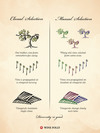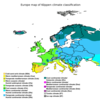The vine, growing environment and vineyard management (ch4-7) Flashcards
Name the two vine species that we can identify, and describe what they are used for.

- Vitis vinifera; the main Eurasian species producing nearly all grapes for wine production
- American vines. Rarely used for wine production because of unattractive flavours, but produce rootstocks to which Vitis vinifera can be grafted. American vines are resistant to Phylloxera.

Describe the two techniques the vinegrower can use to grow or propagate a grape variety.

- Cutting. Take a section of a vine shoot and grow it as a new plant
- Layering. Bend down a cane and lead it under the ground, make it come up somewhere else. The part underground starts growing roots, and then is cut from the original plant.
So all grapes of one variety are identical, and the group of individual plants can be traced back to the original plant through a series of cuttings and/or layerings.

What is a ‘cultivar’?

A cultivar is the same as a variety (vine variety or grape variety)

What is a ‘clone’, and describe ‘clonal selection’.

A clone is an individual vine or group of vines that shows a particular set of unique characteristics (for example high drought resistance, disease resistance or certain flavour characteristics).
Clonal selection is propagation by cutting or layering of vines with positive mutations from an original variety, so the positive characteristics of this mutation can be carried forward in new plantings.

Describe how a new grape variety is created by fertilization, and why only occasionally this yields positive results.

A new grape variety is formed by cross-fertilization, bringing pollen from the male part of the flower of a vine to the female part of the flower of another vine. The pollinated flower develops into a grape with seeds that can start to grow the new variety.
Many seeds are needed for cross-fertilization, and many seedlings fail in the first two years. On top, it takes many years before you have production of a new variety and the quality and characteristics can be judged. So this process is costly and time-consuming.

What is a crossing? Give two examples of well-known crossings in the wine world.

A crossing is the production of a new grape variety from two parents of the same species (so two parents of Vitis vinifera!).
Examples are:
Cabernet Sauvignon = Cabernet Franc x Sauvignon Blanc
Merlot = Cabernet Franc x Magdeleine Noire des Charentes
Müller Thurgau = Riesling x Madeleine Royal
Pinotage = Pinot Noir x Cinsault

What is a hybrid? Give one example of a well-known hybrid.

A hybrid is a vine whose parents are from two different species (Note: a clone comes from two parents of identical species!).
An example is Vidal (Canada), Baco Noir (Canada), Rondo (Europe) and Regent (Europe)

Describe what Phylloxera does to the vine.

Phylloxera is an insect that feeds on the roots of the vine. Infections can enter through the feeding wounds and infect the vine roots, weakening the roots and ultimately make the vine die.
American vines have a sap that clogs the mouth of the insects and form protective layers that close the feeding wounds so no infections can occur.

Describe the two forms of grafting.

Grafting is to join a rootstock to a Vitis vinifera variety (providing the protection to Phylloxera of the rootstock and the flavor of the European vine.
- Bench grafting joins two sections of cane of both the Vitis vinifera and the rootstock variety by machine, stored in a warm environment to make the two parts fuse.
- Head grafting happens in the vineyard, cutting an existing vine back to its trunk or a cutting of the new variety is grafted onto the trunk.

Describe the four ‘green parts of the vine’.

The green parts grow each new year on the shoots (one-year-old wood):
- Buds: forming in the joint between the leaf and the shoot; they develop all structures that form shoot, leaves, tendrils and flowers the next year).
- Tendrils: these tendrils grip a supporting structure such as a trellis wire and wind itself around it to keep the shoots upright and support the shoots
- Leaves: Responsible for photosynthesis (sunlight is used to convert water and carbon dioxide into glucose and oxygen)
- Flowers and berries: flowers are the reproductive organs with male and female parts. Successful pollination makes a berry grow.

Describe the transformation over winter of the shoots and one-year-old wood.

Over winter, the shoots of the previous year become woody and are the one-year wood of next year. In spring of the next year, the buds burst and grow into the new shoots.

What are the two names for the one-year-old wood after winter pruning?

- A cane: long one-year-old wood with 8-20 buds
- A spur: short one-year-old wood with only 2-3 buds

What are the three functions of the roots of a vine?

- Absorb water and nutrients from the soil
- Anchor the vine
- Store carbohydrates to survive the winter

Explain the difference between budburst and fruit set.

Budburst happens early spring, and marks the start of the growth of new shoots.
Fruit set happens late spring, when the vine starts to flower and grapes start growing.

What is the defining factor determining whether a particular grape can grow somewhere?

Heat. The vine needs heat for flowering, fruit set, and ripening.

Name one soil factor that can make a vine-growing area warmer, and one soil factor that can make a vine-growing area cooler.

Warmer: dark soils, soils with high stone and rock content ensure that warmth is reradiated onto the vines.
Cooler: soils with high water content are cooler as they transport heat away from the vine.

Which factors in the vineyard contribute to the amount of heat the vine receives?

Except for sunlight, there is:
- latitude (30-50 deg regions)
- altitude
- ocean currents (Humboldt cools, Gulf Stream warms)
- fog
- soil
- aspect (the direction the vineyard faces, and the steepness)

Explain the difference between continentality and diurnal range.

Continentality is the difference in temperature between the coolest and warmest month (areas close to water masses generally have lower continentality, further inland higher continentality: continentality determines the length of the growing season)
Diurnal range is the difference in temperature between day and night (warm nights accelerate ripening, cool nights help to slow the loss of aromas and acidity: cloud cover reduces diurnal range (warmer nights, cooler days))


























































